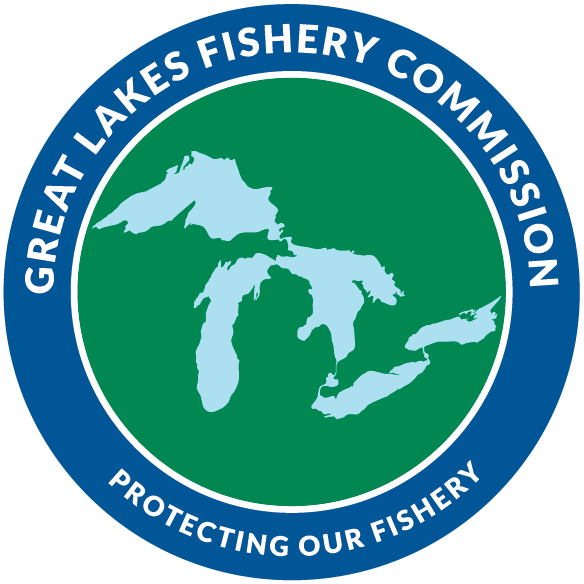Updated 2025-03-22 15:42:02
Lake Huron -> 1.0 Salmonine (Salmon and Trout) -> Lake Trout Mean Age
Reporting Interval
2018 - 2022
Area
lakewide
Meeting Target?
Does Not Meet
Indicator Trend
No trend
Confidence?
High
1.2.3. Lake Trout age structure
Expansion of the age and size composition of populations in Michigan waters of Lake Huron is a positive step towards Lake Trout rehabilitation. In Michigan waters of Lake Huron, mean age of stocked Lake Trout increased to over 10 years by 2010, and mean age of wild Lake Trout increased to over eight years by the end of the 2010s (Figure 1). Declines in annual mortality rates in populations occupying Michigan waters have facilitated expansion of age structure in both hatchery and wild populations.
Ebener (1998) identified two recovery thresholds for mean age of adult Lake Trout. The first threshold is that the average age of hatchery-reared, mature Take Trout is one year older than the average age of first maturity, which agencies have identified as age-6. The subsequent threshold is that the average age of wild, mature Lake Trout should be 9.5 years in the northern and offshore areas of the main basin and 8.5 years in Georgian Bay and in the southern waters of the main basin.
The first threshold was achieved in all basins of Ontario by the mid-2000s, although the average in Georgian Bay subsequently stalled near or just below age-6 (Figure 2). Progress towards achieving the second threshold (i.e., ~age-9) is closest in the main basin, intermediate in the North Channel, and consistently low in Georgian Bay (Figure 3). The overall threshold for average age of wild adults in Ontario waters has not been consistently achieved in any of the basins.
Mean age of Lake Trout captured in Michigan Department of Natural Resources annual spring gill net surveys in Michigan waters of Lake Huron, 1975-2023.
Mean age of stocked (clipped) adult Lake Trout from Ontario commercial fishery samples
Mean age of wild (unclipped) adult Lake Trout from Ontario commercial fishery samples.
Methodology
Michigan waters: Michigan Department of Natural Resources gillnet surveys use multi-mesh, multifilament nets and are conducted from late April through early June before the water column becomes thermally stratified. Surveys cover all Michigan nearshore areas at selected fixed survey stations. Gillnet gangs include nine single-mesh panels each 30.5 m long and 1.83 m tall, with stretch mesh sizes of 50.8 to152.4 mm in 12.7 mm increments. Gillnets were set on the bottom and fished overnight. All hatchery-reared Lake Trout were identified based upon the presence of a fin clip, whereas unclipped individuals were considered wild. Age assignments were based on coded-wire tag information for hatchery fish and sectioned maxilla for wild fish.
Ontario waters: Data provided by the Upper Great Lakes Management Unit (UGLMU) of the Ontario Ministry of Natural Resources (MNR). Average age of adult Lake Trout was estimated from biological samples collected from the commercial fishery. Individuals with total length > 532 mm were considered adults. Commercial catch sampling has been conducted annually since 1975. Onboard observations of catches and biological sampling of fish from Lake Huron commercial fishing vessels was conducted by UGLMU fisheries technicians.
Other Resources
Ebener, M. P. [ED.]. 1998. A lake trout rehabilitation guide for Lake Huron. Great Lakes Fishery Commission. 48 p.
He, J.X., Ebener, M.P., Riley, S.C., Cottrill, A., Kowalski, A., Koproski, S., Mohr, L., and Johnson, J. E. 2012. Lake trout status in the main basin of Lake Huron, 1973–2010. North American Journal of Fisheries Management 32: 402–412.
Murphy, E.W., Smith, M.L. He, J.X., Wellenkamp, W., Barr, E., Downey, P.C., Miller, K.M., Meyer, K.A., 2018. Revised fish aging techniques improve fish contaminant trend analyses in the face of changing Great Lakes food webs. Journal of Great Lakes Research 44: 725-734.
Wellenkamp, W., He, J. X., and Vercnocke, D. 2015. Using maxillae to estimate ages of Lake Trout. North American Journal of Fisheries Management 35: 296-301.
Contributing Author(s)
- Ji He - Michigan Department of Natural Resources
- Jose Bonilla-Gomez & Scott Koproski - United States Fish and Wildlife Service
- Stephen James & Chris Davis - Ontario Ministry of Natural Resources

